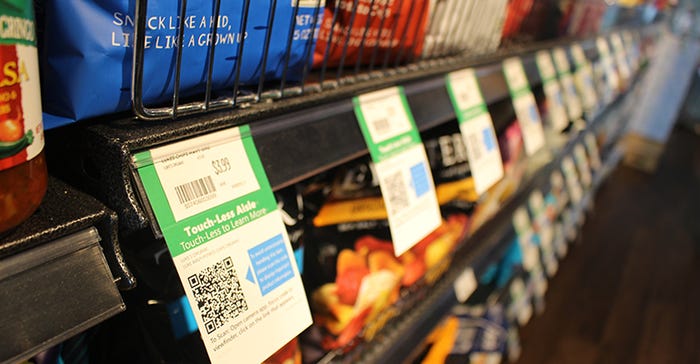Natural retailers test ‘touchless browsing’ tech
Novel system at Native Sun and Raisin Rack uses product data that shoppers can easily access on their phones without handling the product itself.
July 21, 2020

Natural products retailers Native Sun and Raisin Rack have begun testing a new shelf-tag technology that allows consumers to view product information using their smartphones without touching the items.
Although the In-Store Touch-Less Aisle Browsing system is still in the early testing stages, it has already helped enhance the positioning of Native Sun as a retailer that is looking out for the health and wellbeing of its customers, said Aaron Gottlieb, owner of the Jacksonville Beach, Florida, independent retailer.
“Anything a retailer does right now to make customers feel that they have the option to be safer, even if they don't use the tool, means they will believe in you more,” he said.
 Customer response to the system has been highly positive so far because of the added level of safety and sanitation the technology brings, Gottlieb said.
Customer response to the system has been highly positive so far because of the added level of safety and sanitation the technology brings, Gottlieb said.
The Touch-Less Aisle Browsing system allows customers to simply point their phone’s camera at specially created shelf tags to reveal information about a product, including the data found on the nutrition facts panel and the ingredients list. Consumers don’t need to download any apps to use it, which was one of the requirements Gottlieb had for hosting the test in his stores.
Forcing customers to download an app and open it every time they want to scan a product would not be as effective as simply allowing them to point their camera phone at the shelf tag, he explained.
“You just open up your phone and you roll over the product, and it instantly loads up information on that product,” Gottlieb said. “It's the right type of use to have a good in-store experience.”
Gottlieb said he currently has tags installed on the shelves for about 800 of his top-selling CPG items. The original goal was to begin with about 1,000 items, but some products have experienced supply disruptions during the COVID-19 pandemic and are currently unavailable.
In fact, the decrease in product availability makes Touch-Less Aisle Browsing particularly relevant, said David Williams, executive VP of business development, Cornerstone Consulting, the Tampa, Florida-based firm that supplies the system through its Cornerstone for Natural division. When a preferred item is unavailable, shoppers are more likely to pick up potential replacement products and check the label, he explained, potentially spreading germs from surface to surface.
“We’re turning our stores into a giant Petri dish,” Williams said.

He cited data from C+R Research showing that 88% of shoppers reported being unable to find products they normally purchase. The research also found that 60% of shoppers said they were fearful of shopping in a grocery store, and 35% said grocery stores were not doing enough to protect them.
The problem of customers handling items on the shelves may be particularly acute for natural retailers, as consumers seek out healthy remedies and avoid going to hospitals and doctor’s offices, according to Cornerstone for Natural.
The Touch-Less Aisle Browsing system uses enhanced QR codes from Cornerstone called Eli Codes, which have been created for more than 100,000 natural, organic and specialty products using data from the IX-ONE database of product information. The Eli Codes are displayed on shelf talkers that inform customers how to scan the tags to obtain product information. Shoppers see color-coded buttons on their smartphone screens that provide access to nutritional and ingredient content, among other data.
Suppliers also have the opportunity to enhance or upgrade the product information that is associated with each code, to include content such as videos, documents and URL links. In addition, Williams said the tags can be a useful tool for store employees when providing assistance to shoppers.

Don Caster, owner of Raisin Rack, which operates two natural food stores in Ohio, said he is enthusiastic about testing the Touch-Less Aisle Browsing system because of the added information it provides for shoppers.
“I am a firm believer that the more information you can get to the customers, the better they can make good decisions,” he said. “I am looking at this for the long term, not just for what is happening now because of the virus.”
While QR codes have been used in supermarkets for several years, the Touch-Less Aisle Browsing system is much easier for the retailer to install and manage, Caster explained.
Raisin Rack is in the early stages of implementing the new system, he said, and doesn’t have any customer feedback yet. Plans call for the shelf tags to highlight Raisin Rack’s 1,000 top-selling items. He said he plans to promote awareness of the tags using social media and in-store materials.
Williams said non-slip floor decals and encouragement from employees can also help promote the use of the system.
Like Gottlieb of Native Sun, Caster said he views In-Store Touch-Less Aisle Browsing as a potential differentiator for his stores against competitors.
“As we try to survive in this crazy, crazy competitive environment out there, we are trying to create a positive experience,” he said.
“The independents can move on a dime,” Williams said. “This is their chance to differentiate themselves and show their customers they care more.”
All images courtesy Cornerstone.
About the Author(s)
You May Also Like




